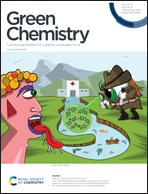Enhanced ammonia selectivity on electrochemical nitrate reduction: Cu–Ni metal–organic frameworks with tandem active sites for cascade catalysis†
Abstract
Electrocatalytic reduction of nitrate represents a carbon-neutral approach to managing wastewater remediation while offering an innovative route for high-value green ammonia synthesis. However, nitrite byproduct is inevitably generated in the electrochemical process, which is more toxic to human beings and limits the conversion efficiency of nitrate to ammonia. Herein, a bimetallic metal–organic framework NixCu(3−x)(HITP)2 (HITP = 2,3,6,7,10,11-hexaiminotriphenylene) is proposed as both a cascade catalyst to eliminate the nitrite and a mechanism platform for the study of the cascade process for nitrate reduction. The bimetallic NixCu(3−x)(HITP)2 platform shows that the Cu sites work as the active sites responsible for the conversion of nitrate to nitrite (NO3− + 2 e− → NO2−). The byproduct NO2− has a tendency to adsorb at Ni sites and further convert to NH3 (NO2− + 6 e− → NH3). By integrating Cu and Ni active centers, the bimetallic MOF strategy synergizes the distinct reaction pathways on heterogeneous metal centers. As a result, compared with monometallic Cu3(HITP)2, the optimal Ni1.5Cu1.5(HITP)2 achieved an outstanding NH3 yield of 130.93 μmol h−1 cm−2 with dramatically enhanced NH3 selectivity. This research elucidates the correlation between structure and activity in bimetallic active sites and cascade catalysis, which offers a high-efficiency nitrate-to-ammonia reduction.



 Please wait while we load your content...
Please wait while we load your content...